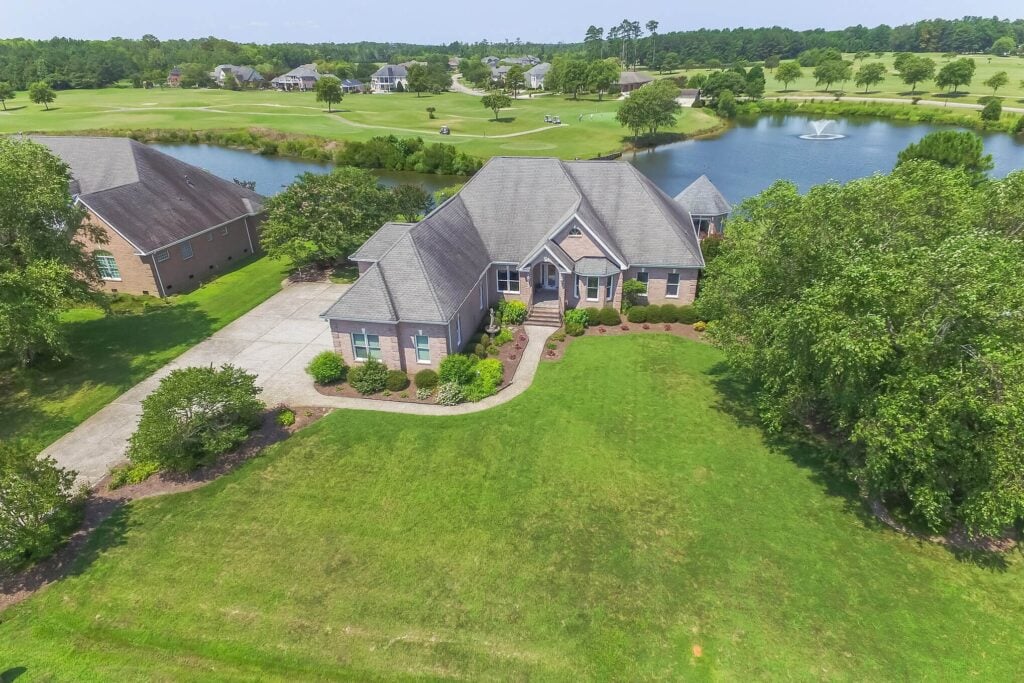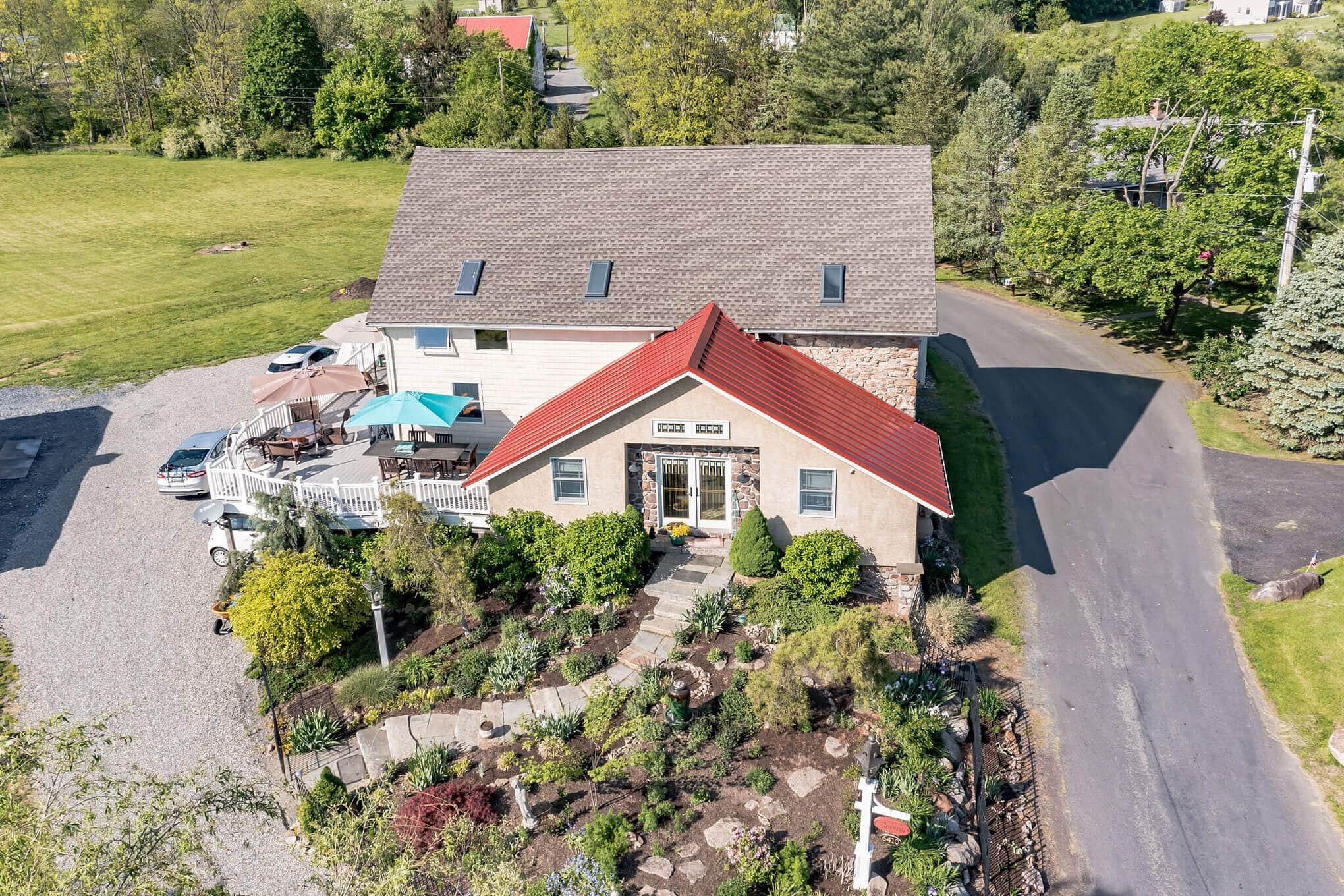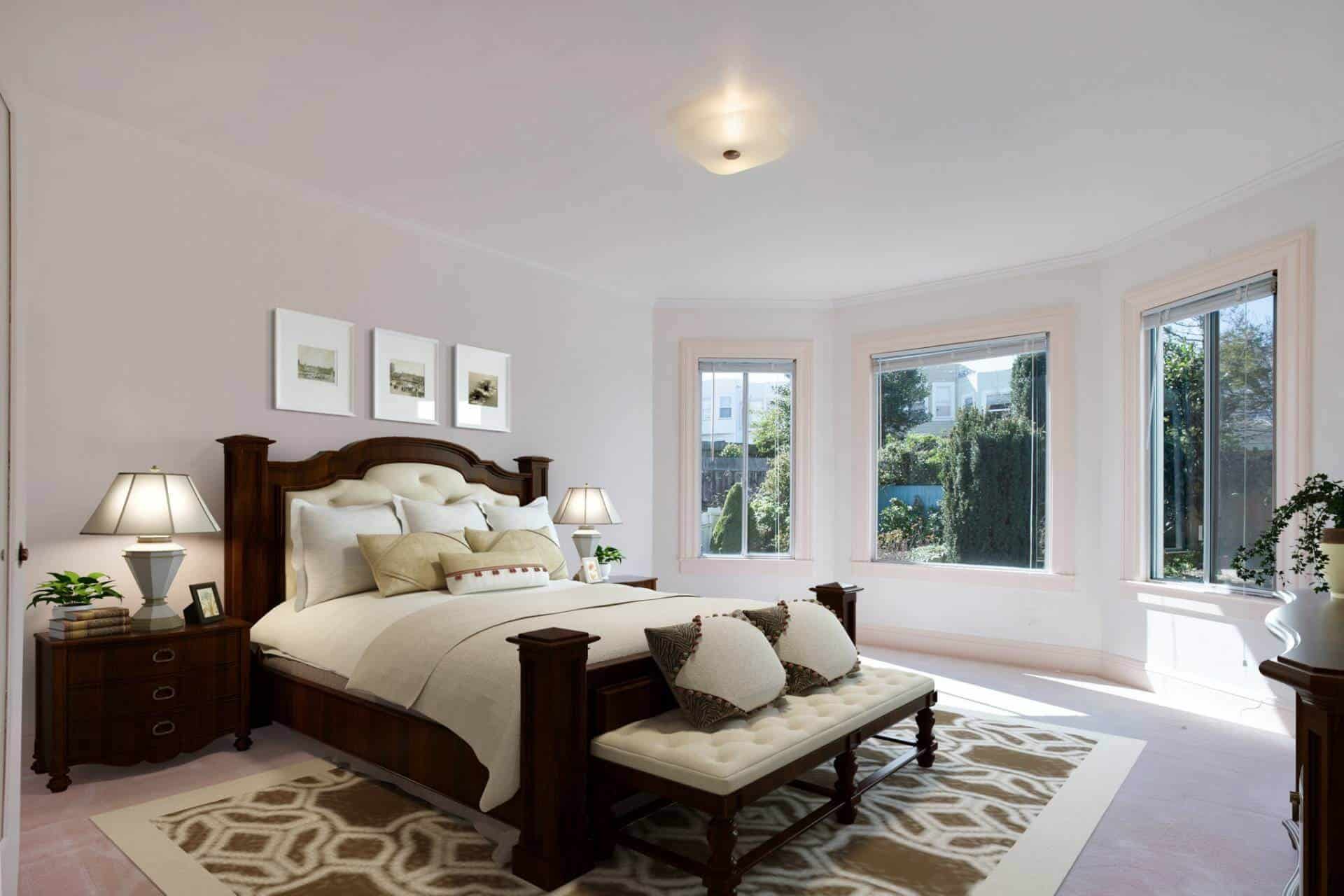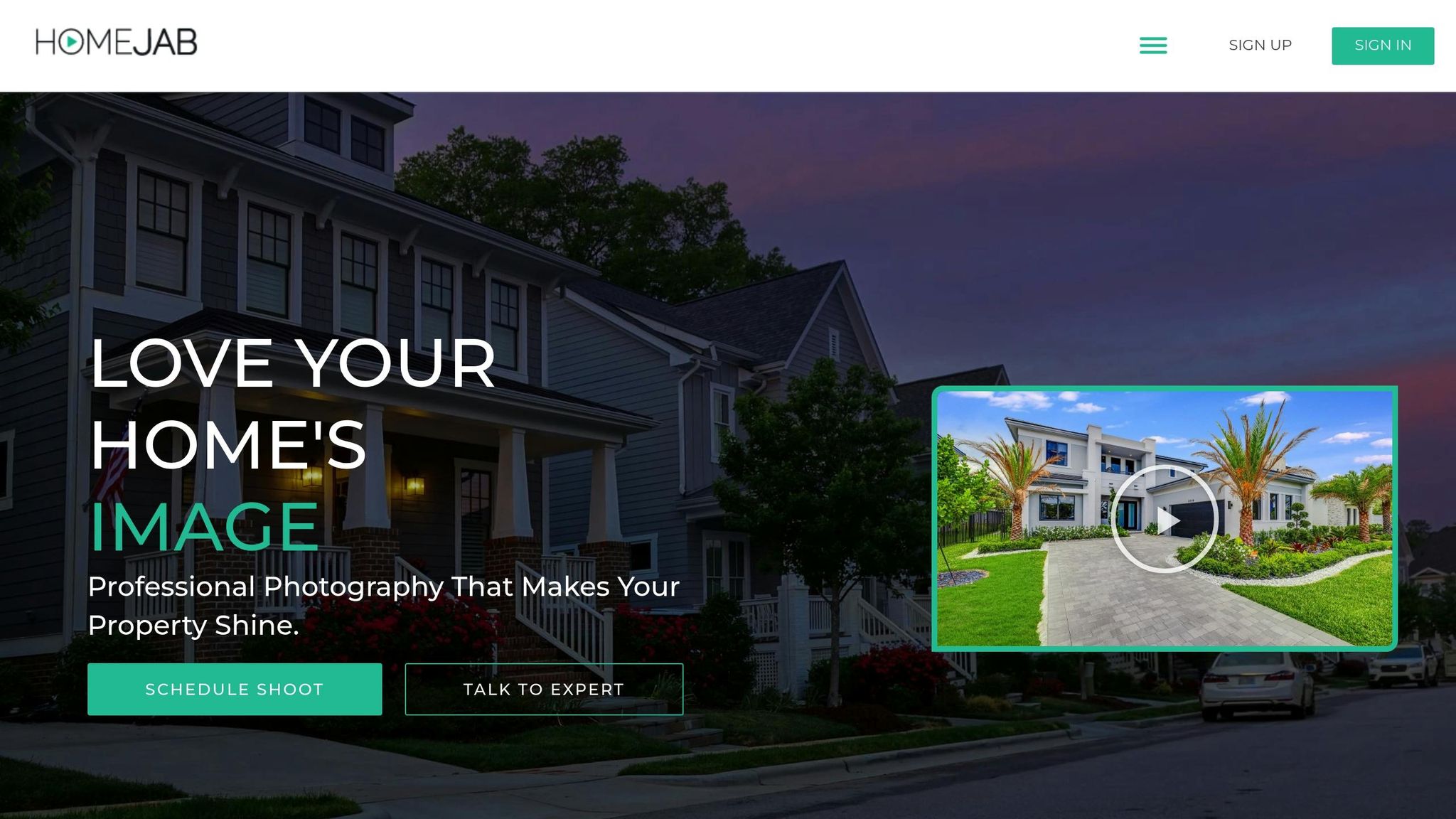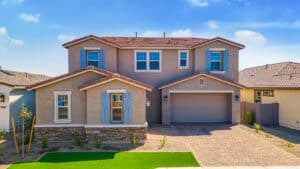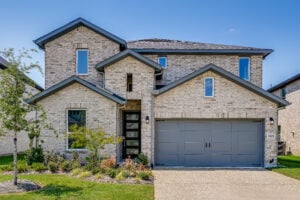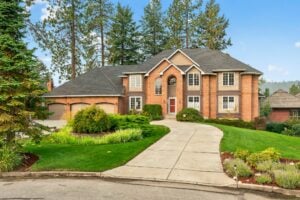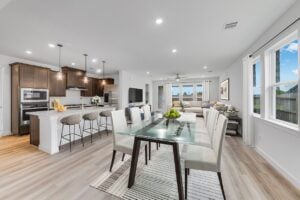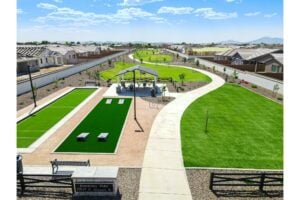When marketing real estate online, videos and photos serve different purposes but work best when combined. Videos create a dynamic, immersive experience, helping buyers visualize layouts and features, while photos offer clarity and a polished first impression. Here’s what you need to know:
- Videos: Ideal for showcasing property flow, unique features, and emotional appeal. Best for social media (Instagram, TikTok) where engagement thrives. Examples include property tours, behind-the-scenes clips, and outdoor highlights.
- Photos: Essential for MLS listings and quick decision-making. They highlight details like interiors, exteriors, and lifestyle elements. Perfect for carousel posts, before-and-after shots, and neighborhood scenes.
Quick Comparison
| Factor | Video Posts | Photo Posts |
|---|---|---|
| Engagement Rate | Higher on platforms like TikTok | Reliable for MLS and static content |
| Production Time | Requires more effort (editing, etc.) | Faster to create |
| Cost | Higher (drone, editing, etc.) | More affordable |
| Best Use Case | Showcasing flow and ambiance | Highlighting specific details |
Takeaway: Use videos for emotional connection and broader reach, while relying on photos for clarity and decision-making. Together, they create a balanced visual strategy that attracts and converts buyers.
Video Posts for Real Estate
Video posts have transformed the way properties are showcased online. Unlike static images, videos offer an engaging, walk-through experience, allowing potential buyers to better understand a property’s layout and feel. Let’s dive into why this format captures attention and drives deeper engagement.
Benefits of Video Posts
The storytelling potential of video is unmatched. A well-crafted video tour can highlight a property’s charm, like the natural morning light streaming into the kitchen or the seamless flow of an open floor plan. By connecting emotionally with viewers, video often inspires stronger interest and quicker decisions.
Social media platforms like Instagram and Facebook prioritize video content, meaning your posts are more likely to reach and engage a wider audience. Videos also encourage longer interaction times, signaling to these platforms that your content is worth promoting.
Virtual walkthroughs are particularly valuable for out-of-town buyers or those with packed schedules. They allow prospects to get a real sense of the space before committing to an in-person visit. Videos can also bring dynamic features to life – think smart home systems, automated lighting, or smooth-operating custom cabinetry. The movement and sound in video add depth, helping viewers appreciate a property’s unique character in ways photos simply can’t.
These advantages make video an essential tool for showcasing properties effectively.
When to Use Video Posts
Some properties and scenarios call for video content more than others. Here are the best opportunities to leverage video:
- Luxury properties: High-end homes deserve cinematic presentations. Video can capture intricate architectural details, the flow of entertainment spaces, and lifestyle amenities like infinity pools or wine cellars, creating the upscale experience luxury buyers expect.
- Unique architectural features: If a property boasts distinctive elements like spiral staircases, vaulted ceilings, or innovative layouts, video is the best way to showcase their impact. Sweeping camera movements can reveal spatial relationships that photos can’t.
- Live streaming open houses: This approach has become increasingly popular for connecting with remote buyers. Real-time video lets you answer questions on the spot while creating urgency for those considering a visit.
- Outdoor spaces: From expansive backyards to waterfront views, video captures these areas beautifully. Seasonal highlights, like blooming gardens or mature trees, are especially compelling when shown in motion.
- Energy-efficient upgrades: Features like solar panels or smart thermostats are better demonstrated than described. Video can show these systems in action, helping buyers see the value they add.
Short-Form Videos on Social Media
Platforms like Instagram Reels and TikTok have reshaped real estate marketing, making it easier to connect with broader audiences. These platforms favor authentic, engaging content over overly polished ads, giving real estate professionals a chance to stand out.
- Quick property highlights: Short videos (15-30 seconds) focusing on a single standout feature – like a stunning kitchen island or a spacious walk-in closet – are perfect for busy users scrolling through their feeds.
- Behind-the-scenes content: Viewers love seeing the process behind the scenes. Show the staging process, preparation for a photoshoot, or even your first reaction to a new property to build a more personal connection with your audience.
- Trending audio and hashtags: Using popular sounds or participating in trends can significantly boost your reach. These techniques often help property videos attract thousands of viewers beyond your immediate followers.
- Vertical format filming: Since these platforms are designed for mobile screens, vertical videos work best. Focus on showcasing vertical elements like tall windows, staircases, or ceiling details to make the most of the format.
- Educational content: Mix property tours with quick tips on home buying, market trends, or neighborhood insights. This not only entertains viewers but also positions you as a knowledgeable resource.
Short-form videos offer a unique opportunity to blend property showcases with engaging, value-driven content, helping you connect with potential buyers in a fresh and impactful way.
Photo Posts for Real Estate
While videos bring properties to life with movement and emotion, photos offer clarity and create that all-important first impression. Oftentimes, a single photo can determine whether a potential buyer pauses to learn more or scrolls past. The right image has the power to stop someone mid-scroll and ignite genuine interest in a property.
In today’s fast-paced real estate market, photos need to convey a property’s appeal instantly. They’re essential for MLS listings, social media posts, and other marketing materials where buyers make snap decisions.
Professional Photography Benefits
High-quality photography can transform how a property is perceived online. HDR photography, for example, captures multiple exposures of the same scene and blends them into one image. This ensures bright windows and darker interior details are both visible, eliminating common issues like harsh shadows or overexposed areas that often plague amateur photos.
Architectural photography takes this a step further, using angles and framing to maximize the visual appeal of spaces. A skilled photographer knows how to make a kitchen island look more expansive, highlight the soaring height of cathedral ceilings, or focus on features that truly showcase a home’s best qualities.
Exterior shots, or curb appeal photography, are equally critical since they often serve as the primary image for listings. Professionals time these shots to capture the perfect lighting – typically during the golden hour – and position the camera to highlight the home’s best angle while minimizing distractions in the background.
The result? Properties with professional photos tend to sell faster and attract stronger offers. High-quality images draw more online views, leading to more showings and, ultimately, more competitive bids.
When to Use Photo Posts
There are specific situations where photos outshine videos. For instance, MLS listings are still primarily photo-driven. Buyers often browse through static images first to decide which properties are worth exploring further. These photos need to quickly tell the story of the home, showcasing each room’s purpose and the overall layout.
On social media, carousel posts are ideal for real estate photography. Platforms like Instagram and Facebook allow users to swipe through multiple images at their own pace, giving them the freedom to linger on rooms or features that catch their eye. This format is perfect for highlighting different aspects of a property, from the inviting entryway to a luxurious master suite, without overwhelming the viewer.
Before-and-after comparisons also shine in photo format. Whether it’s a renovation, staging transformation, or seasonal landscaping update, side-by-side images make it easy for viewers to see the improvement, often leading to high engagement.
Detail shots are another area where photos excel. Close-ups of custom tilework, unique light fixtures, or high-end appliances let buyers appreciate the craftsmanship and finishes – especially in luxury properties where every detail matters.
Lastly, neighborhood and lifestyle photography can help buyers picture themselves living in the area. Photos of nearby parks, coffee shops, or scenic trails go beyond the property itself to showcase the lifestyle that comes with it. These images pair beautifully with video tours, offering a well-rounded view of what the home and its surroundings have to offer.
Virtual Staging for Photos
Virtual staging takes traditional photography to the next level by digitally adding decor and furniture to images. This technology helps buyers visualize a home’s potential without the expense or hassle of physical staging.
For vacant properties, virtual staging is especially useful. It transforms empty rooms into inviting spaces, showing buyers how furniture fits and how the layout works for everyday living.
Older properties can also benefit. Virtual staging can update the look of a home by swapping outdated wallpaper for modern paint colors or replacing dated fixtures with contemporary alternatives. This allows buyers to focus on the property’s potential rather than its current cosmetic flaws.
Cost-wise, virtual staging is a budget-friendly option. Services like HomeJab charge around $50 per photo, a fraction of the cost of traditional staging. Plus, the process is quick – often delivering results within 24 hours compared to the longer timelines required for physical staging.
The key to successful virtual staging is keeping it realistic. The furniture and decor should be appropriately scaled to the room, and the style should remain neutral to appeal to a wide range of buyers. Done right, virtual staging enhances a property’s appeal without misleading potential buyers.
Next, we’ll dive into a comparison of photos versus videos to help you choose the best format for your listing.
Video vs. Photo Posts: Direct Comparison
Deciding between video and photo posts means understanding how each format impacts engagement and influences decisions. Both have their strengths and serve different purposes, so knowing when to use each can help you meet your marketing goals while keeping costs in check.
Videos often generate more interaction on social platforms, but photos are essential for MLS listings, where buyers expect crisp, high-quality images. Let’s break down the differences in terms of production, cost, and audience engagement.
Photos are quicker to produce, while videos require more effort – planning, specialized equipment, and extensive editing. Even a simple walkthrough video demands attention to lighting, smooth camera work, and clear audio to hold viewers’ attention.
Cost is another factor. Professional photography is generally more budget-friendly, while video production can rack up expenses, especially with features like drone footage or advanced editing.
The platform you’re targeting also matters. Instagram Stories and TikTok thrive on short, dynamic videos, while LinkedIn and MLS platforms are better suited for static, high-quality images. Facebook and Instagram feeds can handle both formats, provided they play to each medium’s strengths.
Comparison Table: Key Metrics
| Factor | Video Posts | Photo Posts |
|---|---|---|
| Engagement Rate | Higher on social media platforms | Reliable for driving conversions in listings |
| Production Time | Longer process with planning and editing | Faster and simpler to execute |
| Cost | Higher due to advanced features like drones | More affordable for standard property shoots |
| Information Depth | Showcases flow, scale, and ambiance | Highlights specific features and details |
| Platform Fit | Ideal for dynamic platforms (e.g., TikTok, Instagram) | Best for MLS and professional platforms (e.g., LinkedIn) |
| Viewer Control | Linear experience controlled by the creator | Self-paced browsing by the viewer |
| Storage/Loading | Larger files, slower to load | Smaller files, quick to load |
| Accessibility | Requires captions or transcripts for all users | Screen reader-friendly and easy to navigate |
| Longevity | Short-term appeal, often seen as trending | Evergreen content with lasting value |
Videos are great for grabbing attention quickly, especially with compelling openings. In contrast, photos allow viewers to linger and examine details at their own pace.
High-quality images, paired with detailed alt text and descriptions, perform exceptionally well in image search results. Videos, on the other hand, benefit from transcripts and thorough descriptions to improve search visibility. While photos load faster and don’t rely on audio – perfect for buyers on the move or in quiet spaces – videos often require more bandwidth and are most effective with sound.
When it comes to conversions, the two formats complement each other. Videos work well for sparking initial interest and engagement, but high-quality photos are key for generating inquiries and helping buyers make final decisions. Videos capture attention, while photos close the deal.
Understanding these differences allows you to allocate your budget wisely and choose the right format for each campaign.
Using Video and Photo Content Together
Why choose between video and photo content when you can use both? Combining these two formats is a smart way to increase property visibility and keep potential buyers engaged. By blending the strengths of each, you can appeal to a variety of buyer preferences and guide them through different stages of their decision-making process. Let’s explore how this combination works.
Combining Both Formats
Photos are your first chance to grab attention. Crisp, high-quality images highlight a property’s exterior charm, unique architectural details, and key interior features. They’re perfect for creating that all-important first impression on online listings. Videos, on the other hand, bring the property to life. They offer a dynamic, immersive experience, giving viewers a real sense of the layout and functionality.
The approach can vary depending on the type of property. Residential homes benefit from stunning photos to showcase curb appeal and videos to illustrate how spaces flow together. Meanwhile, commercial and industrial properties can use both formats to emphasize design elements and practical features. Tools like drone footage and 360-degree tours add another layer, offering aerial views and interactive experiences that highlight the property and its surroundings. Virtual staging is another powerful option – it transforms empty spaces into inviting, fully furnished rooms, enhancing both photos and videos.
Content Planning and Scheduling
To get the most out of your visual content, you need a solid plan. A content calendar can help you organize high-quality photos and engaging videos while keeping track of what works. Listings that combine these formats tend to attract more views and interactions. For efficiency, consider scheduling photo and video shoots together. This not only ensures consistency in lighting and style but also helps you make the most of your time and budget. With a strategic approach, you can create a visually cohesive and compelling marketing campaign that stands out.
Professional Video and Photo Services with HomeJab
Professional services are the cornerstone of creating standout visual content for real estate. High-quality photos and videos require both expertise and advanced equipment – something a smartphone just can’t replicate.
HomeJab Services
HomeJab offers a wide range of visual content services tailored specifically for real estate professionals. Here’s what they bring to the table:
- HDR Photography: Captures lighting perfectly, balancing bright and shadowy areas to highlight every detail.
- Video Tours: Smooth, professionally shot walkthroughs that showcase key features and create an emotional connection with viewers.
- Aerial Photography and Drone Videos: Provides stunning overhead shots that highlight property boundaries, neighborhoods, and outdoor features – ideal for larger properties or those with unique landscapes.
- 3D Virtual Tours: Interactive, 360-degree experiences that let buyers explore properties at their own pace. Perfect for remote buyers or as a first look before an in-person visit.
- Virtual Staging: Turns empty spaces into beautifully furnished rooms without the expense or hassle of physical staging. Multiple design styles allow customization to appeal to different buyers.
- Floorplan Creation: Gives buyers a clear layout of the property, helping them visualize room relationships and furniture placement.
By combining these services, agents can deliver crisp visuals and immersive experiences that make every listing stand out.
Benefits for Real Estate Professionals
HomeJab doesn’t just deliver professional visuals – it also makes the process seamless and efficient for real estate agents. Here’s how:
- 24-Hour Turnaround Time: Speed is critical in real estate marketing, and HomeJab ensures you get your visuals fast. Quick delivery helps agents maintain momentum in competitive markets.
- Local Expertise: HomeJab connects agents with vetted local photographers who understand the nuances of regional markets and architectural styles. This ensures the content resonates with local buyers and highlights what matters most in each area.
- Customizable Packages: Whether it’s a luxury home needing the full suite of services or a starter home requiring just photos and a basic video, agents can tailor packages to fit their budget and listing needs. Pricing starts at $175 for standard photo packages and goes up to $869 for comprehensive 3D virtual tour packages.
- Bulk Pricing Options: Agents with multiple listings can save more. For every $1,000 spent, HomeJab offers a $50 credit, making it easier for high-volume agents to consistently use professional visuals.
- Nationwide Coverage: Whether you’re in a bustling city or a smaller market, HomeJab delivers the same level of quality. This is especially useful for agents working across multiple regions or referring clients to colleagues in other areas.
- Free MLS and Branded Property Pages: Beyond visuals, HomeJab provides professional property pages that showcase high-quality media while promoting the agent’s brand. These pages are optimized for social media and email campaigns, extending the reach of your marketing efforts.
With HomeJab, real estate professionals can elevate their visual marketing strategy, ensuring every listing gets the attention it deserves.
Conclusion: Choosing the Right Format for Your Listings
When it comes to real estate marketing, the choice between video and photo posts isn’t about picking one over the other – it’s about finding the right balance. Combining both formats strategically can make your listings more engaging and effective, as discussed earlier. But remember, success hinges on professional-quality visuals that grab attention and leave a lasting impression. A poorly lit photo or a shaky video can turn buyers away before they even consider scheduling a visit.
Using both formats effectively means playing to their strengths. Photos work well for quick property highlights and market updates, giving potential buyers a snapshot of what’s available. On the other hand, videos are perfect for in-depth property tours or showcasing the charm of a neighborhood. Planning your content calendar around these strengths – and aligning it with your audience’s habits – can maximize your reach and impact.
Don’t forget to tailor your approach to the platform. Each platform has its own content preferences, so knowing where your audience spends their time will guide your visual strategy.
To simplify this process, services like HomeJab offer a one-stop solution for real estate professionals. Whether you need professional photography starting at $175 or full 3D virtual tour packages up to $869, they provide high-quality visuals that meet the demands of both photos and videos. With a 24-hour turnaround and nationwide availability, you can maintain consistent quality across all your listings – whether it’s a charming starter home or a luxurious estate. This ensures your marketing stays sharp and competitive without the hassle of juggling multiple vendors.
FAQs
How can using both video and photo posts improve my real estate marketing?
Using both videos and photos in your real estate marketing can make a big difference in capturing attention and keeping potential buyers engaged. Videos add energy and depth, offering a virtual tour that helps viewers imagine themselves in the space. They create an emotional connection by bringing the property to life in a way static images simply can’t.
On the other hand, photos deliver sharp, detailed views of key features, making it easy for buyers to focus on the highlights at a glance. Together, these two formats work hand in hand to provide a well-rounded and visually appealing presentation of your listings. This combination not only boosts interest but also encourages inquiries and builds trust with your audience, helping to move properties faster.
What should I consider when comparing the costs of video and photo posts for real estate listings?
When it comes to costs, video posts tend to be on the pricier side. Basic videos typically start at around $300, while more polished, high-quality productions can exceed $2,000. This higher price tag often reflects their ability to drive engagement and generate inquiries, making them a strong choice for competitive or high-value listings.
In contrast, photo posts are usually more budget-friendly. Professional real estate photography often comes in under $500, yet it still packs a punch. High-quality photos can effectively highlight a property’s best features and help it stand out in a crowded market.
Deciding between video and photo posts really boils down to your budget, the audience you’re targeting, and the level of visibility you’re aiming for. Choosing the right format can elevate your listing’s appeal and potentially speed up the sales process.
When should I use video instead of photos to showcase a property?
Video is a fantastic tool for giving potential buyers a deeper, more engaging look at a property. Unlike static photos, videos allow you to showcase the layout, flow, and overall vibe of a home. They’re perfect for highlighting standout features, expansive interiors, or outdoor spaces that come to life with movement and perspective.
On top of that, videos grab attention on social media, making them ideal for promoting luxury properties or crafting a compelling story around a listing. If your aim is to make a strong impression and generate more inquiries, video content is the way to go.

